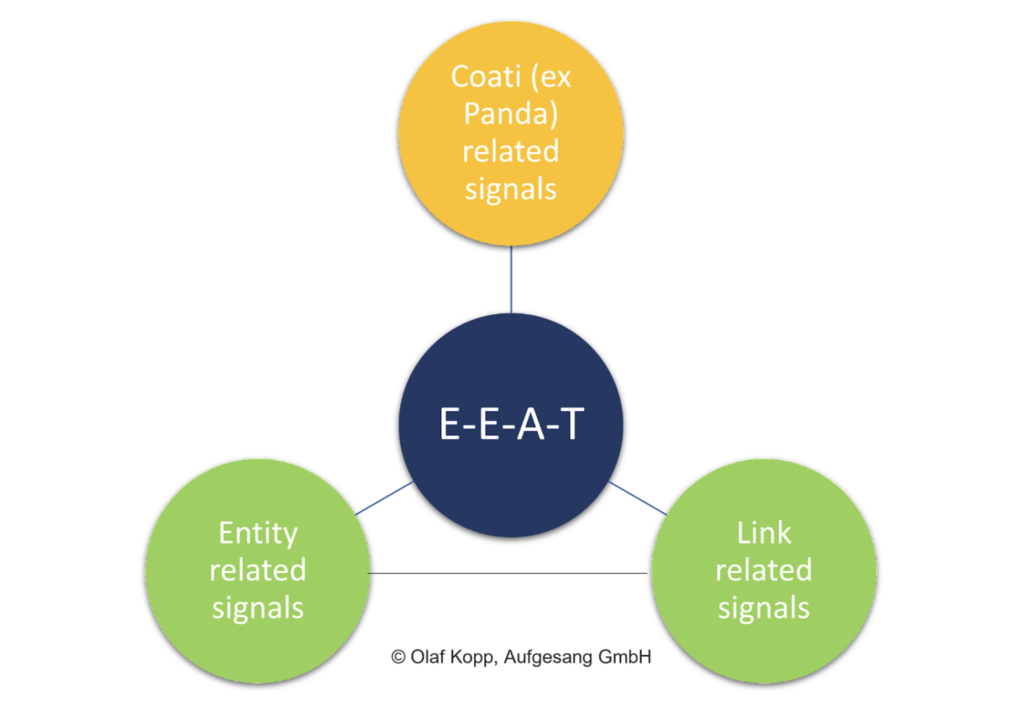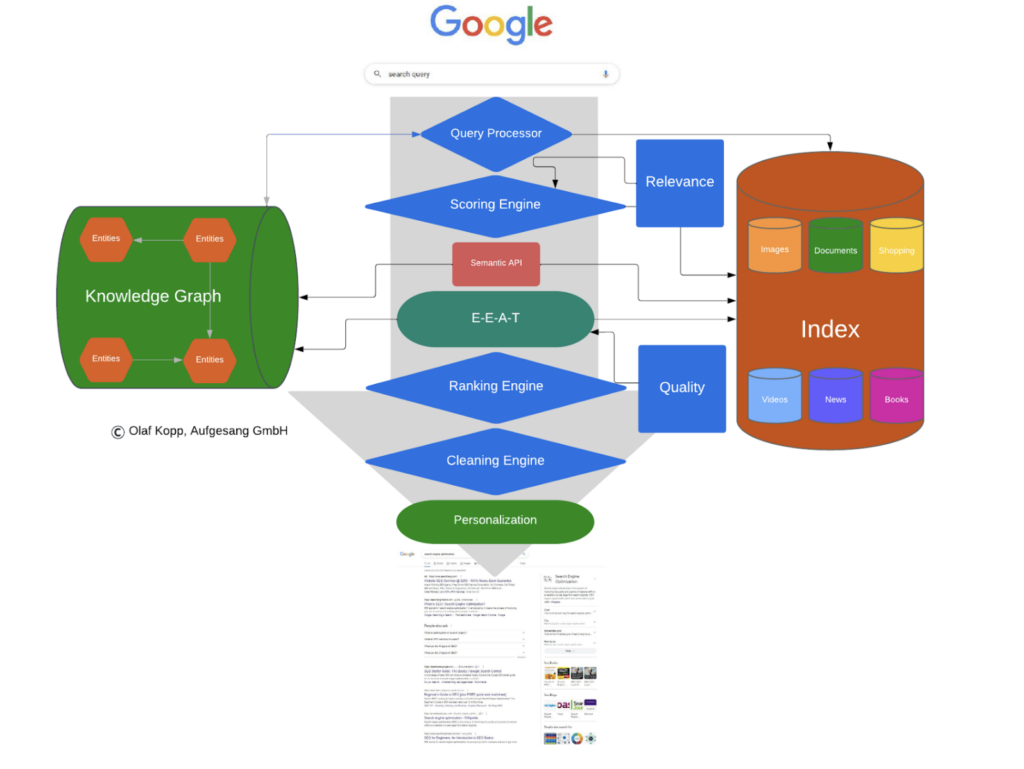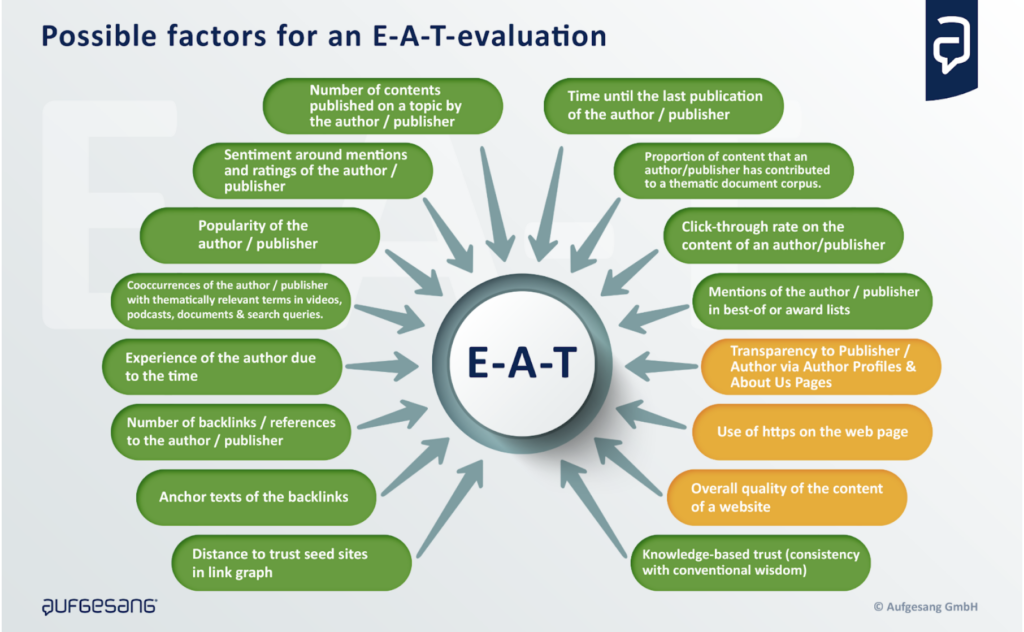In May 2014, I wrote a post titled “Branding and the new Google ranking: why SEO is no longer enough…” (only in German). Almost 10 years later, it’s time for an update, because a lot has happened. A few months after the aforementioned post, Google introduced the E-A-T concept in the Quality Rater Guidelines, which is now called E-E-A-T.
At that time, E-A-T was a theoretical concept that helped search evaluators assess high-quality sources and content. This feedback has since been used as training data in Google’s ranking algorithms.
At that time, one could only guess what influence E-E-A-T would have on search in the future. I was fascinated by the concept from the beginning, as I had already been working intensively on the connection between branding and ranking for some time. In the SEO industry, however, E-A-T only really found attention with the official naming in relation to the Core Updates in 2018.
E-E-A-T is one of the most important components for ranking on Google today and for keywords on YMYL topics, it is the gatekeeper for the first Google SERP.
This article will explain why we hardly have a chance to rank on the first page of Google’s search results without E-E-A-T, especially for keywords with high competition and keywords on Your-Money-Your-Life topics and why SEO alone is not enough for this.
E-E-A-T is a fundamental break in the way Google ranks websites and requires a holistic view looking outside the SEO box.
What is E-E-A-T?
E-E-A-T is Google’s quality concept to identify thematic authorities and trustworthy entities that are subsequently taken into account when ranking individual documents. It’s a theoretical concept meant to show that Google values experience, expertise, authority and trust when ranking websites.
E-E-A-T is a continuation of the way brands are considered when ranking, which started with the 2009 Vince Update. In my opinion, it consists of various components or updates.
At the content level, elements from the ranking systems Panda or Coati and Helpful Content are integrated into E-E-A-T. In addition, signals act on link level and entity level.

E-E-A-T primarily relates to thematic areas and is to be understood as a rating layer that evaluates collections of content and off-page signals relating to entities such as companies, organizations and people rather than individual documents.

To evaluate the relevance of individual content in relation to individual search queries, Google looks at classic information retrieval factors such as keywords in content elements like page titles, headings, document structure, and use of semantically related keywords (TF-IDF) … on a document level.
On a meta level, Google then evaluates the content’s publisher or the author in terms of general quality in relation to a theme via an interplay of signals at the content level and off-page level.
E-E-A-T in terms of crawling and indexing
With the triumph of AI tools like ChatGPT or jasper.ai for content creation, Google faces a major challenge. On the one hand, Google has to use its own crawling resources efficiently. This means that Google does not want to crawl all content accessible online. The same applies to indexing. It makes no sense for Google to include inferior content in the search index. The more content Google indexes and has to process in the information retrieval process, the more computing power is needed.
Google performs document scoring only on the top documents of a thematically relevant document corpus, the rest is not ranked for efficiency reasons. Still, unneeded content costs unnecessary storage, parsing and rendering resources.
E-E-A-T can help Google to rank based on entities or domain and author level applied in the big scale without having to crawl all content. At this macro level, content can be classified according to the author entity and given more or less crawling budget. In addition, Google can exclude entire content groups from indexing via this path.
Google has repeatedly emphasized that quality plays a special role in crawling and indexing (see here and here)
Vector space analysis for relevance and quality determination
Modern search engines are increasingly using vector space analysis to determine relevance and quality. Individual words as well as complete phrases and entities can be set up as vectors in thematic spaces and related to one another.
The Google patent, “Website representation vector to generate search results and classify website“, describes how a search engine can map websites as vectors and evaluate them with quality scores with regard to topics. Only websites where the quality scores reach a certain threshold are considered for a ranking for corresponding keywords.
The classification can be determined, for example, based on the level of expertise of the authors:
For instance, the website classifications may include the first category of websites authored by experts in the knowledge domain, e.g., doctors, the second category of websites authored by apprentices in the knowledge domain, e.g., medical students, and a third category of websites authored by laypersons in the knowledge domain.
You can read more about the patent in this post by the late and dearly missed SEO pioneer Bill Slawski.
Off-page and on-page signals for an E-E-A-T rating
In the following graphic, I summarize possible signals for an E-E-A-T assessment. However, for the purposes of this article, we won’t go into great detail about the individual signals. If you’d like to find out more, you can peruse the article, 14 ways Google may evaluate E-A-T.

Ranking today = SEO + (content) marketing + PR
The topic of marketing used to play a role only in search engine optimization in relation to your own brand terms. Establishing oneself as a brand or authority in a certain subject area could be ignored by SEOs in the pre-E-A-T era.
However, that has since changed with the final introduction of the semantic search through the Hummingbird update and Google’s efforts to establish E-E-A-T. As such, large parts of the influencing factors for the ranking are no longer the same.
By building a semantic entity-based index such as a knowledge graph and ranking algorithms that recognize semantic relationships, authors and their domains can be evaluated in terms of E-E-A-T.
Before 2013, almost everything in search engine optimization revolved around the html document to be optimized itself and its external linking.
With the introduction of semantic search, the focus shifts away from the document to the originator or author, the brand, authority or domain itself. The effects of this development can be seen in very competitive industries and in YMYL topics and keywords from these subject areas.
In the niches, it is currently still sufficient to ensure good rankings with the usual SEO craft at document level.
The following areas, among others, can have an influence on E-E-A-T:
Domain-level links and anchor text
In the past, links and anchor text were primarily important for landing page rankings. In times of E-E-A-T, these signals are also becoming increasingly important for the entire domain.
Co-occurrences
Co-occurrences in documents and search queries of author or company names and thematic terms. The frequency with which authors and companies are mentioned in thematic contexts, both in content and in search queries, indicates a high level of authority.
Document-internal knowledge graphs
Expertise can be determined algorithmically by comparing the similarity of document-internal knowledge graphs with those of high-quality authoritative resources.
Percentage of content contributed to a thematic overall document corpus
The more content an originator has contributed to an overall thematic corpus of content, the better it is in terms of E-E-A-T.
User signals
Content that is consumed particularly frequently in relation to the relevant thematic search queries indicates a high quality of the content and E-E-A-T of the author.
Topical authority
The more detailed a domain’s content corpus deals with a topic, the more likely it is that the searcher will find all the information.
As you can see, some areas are about content marketing and others are about marketing and PR.
[Ebook] Data SEO: The Next Big Adventure
SEO alone is often no longer enough for good rankings
When ranking, Google attaches great importance to how relevant you are as an entity, authority and brand in one or more subject areas.
For good rankings, it is therefore important to focus intensively on the content available on your own domain and other media. It is also important to get users to search for your own brand in search engines in the relevant contexts or to get multipliers to report about your own brand in positive thematically appropriate contexts.
This is how you generate positive signals in the sense of E-E-A-T.
Since you have to convince Google that you, as a website, but also as an author, are a brand, authority or beacon in the industry, marketing with a focus on Google can also be referred to as Google branding or digital brand building.
In the book “Google Semantic Search” by David Amerland, he describes the following important SEO activities:
- Creating extensive content that connects everything your business does in a meaningful way.
- Guiding the online conversation in social media networks in ways that extend the boundaries of what your company and brand does.
- Using your social network profiles to link to content that adds further value to what you do.
Amerland cites the following examples as part of the “new SEO”:
- Good quality content that delivers value to the end-user.
- Websites that offer an excellent online visitor experience in terms of use, content and navigability.
- Businesses that are being talked about on the web, on blogs, and social networks.
- Businesses whose content is reshared on the web across social networks.
- Businesses with a strong social component that actually engages their prospective customer in a personal way.
- Businesses that stay current and generate consistently fresh content proving that they both have something to say and that they are part of the current online conversation.
- Setting a monetary value to reputation.
- Understanding the need to build and maintain trust.
What does this have to do with SEO in the strictest sense?
Not much! Many signals that can have a positive impact on E-E-A-T are the responsibility of content marketing, PR, and marketing.
It’s no longer possible without the others
It is becoming increasingly important for SEO to see itself as an interface and coordinator within the company. SEO needs to become more of a cross-departmental discipline that seeks a place somewhere between marketing, PR, data, content creation and IT. The nerdy basement kid who decodes the secrets of the Google algos in his locked room is nowadays more of a wistful fantasy.
In a more accurate description, the SEO proactively advises all neighboring departments with interface relevance and is accordingly provided with the necessary influence from the heads of each department. The consideration of SEO in all neighboring search-relevant areas is a must in this role and is accordingly anchored in processes. However, this also includes a certain assertiveness and talent for leadership in order to get everyone involved on board.
The main focus here is to advise and train all those involved so that they can largely implement the processes or strategy themselves. For this purpose, SEO should also be integrated in the processes, e.g. in editing, content creation, PR, IT, etc… In-house SEOs as well as external consultants or agencies can take on this job. SEO can also be effective in the HR department to make job postings easier to find.
On the other hand, SEO needs information from market research, marketing, sales, SEA, UX and IT/development in order to work optimally. Formats for exchange are needed here.

Overall, the role of an SEO has evolved to be more inclusive and holistic. If you’d like to read more about the new role of SEO, you can check out this post: “The role of successful SEO: Consultant, Interface, Enabler”.


